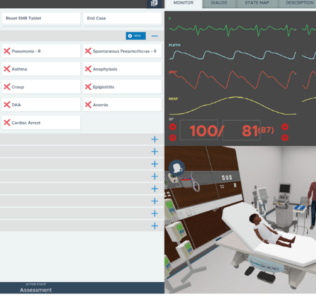ASSIST-U Digital Rectal Examination Simulator from Imperial College London

Recently the Imperial College London put together some research regarding the education of DREs utilizing ASSIST-U haptics simulator system, built by the program. The video below shows the progress of the simulated environment which provides a safe environment to repeatedly perform DREs including: 3D meshes, CTA decision making (state machine), internal view, modeling of coccyx, prostate gland and rectum, as well as haptic effects are integrated. Colored spheres indicate next steps to perform. An internal view shows patient-specific anatomy (from left to right: coccyx, rectum, prostate and bladder). Controls (right-centre) integrate CTA actions. Other controls (top) are set to fine-tune haptic force effects.
Advanced Simulation System for Training Unsighted Examinations and Procedures (ASSIST-U):
Sponsored Content:
The Research Project
Colorectal and prostate cancers are some of the most commonly diagnosed cancers accounting for 13% and 12%, respectively. The early detection of these diseases is essential and Digital Rectal Examination (DRE) plays a crucial role for diagnosis, screening and clinical outcome. During a DRE, a clinician inserts his/her index finger through the back passage in order to examine the rectum and the prostate, while the patient is usually lying on their side with both legs up to their chest. Such examinations are conducted almost entirely by feel as visual cues are minimal. As a result, DRE is uniquely challenging to learn and teach as there is no connection between trainer and trainee. On the one hand, the trainee is unable to see what the trainer is doing and, on the other hand, the trainer is unable to feel what the trainee is feeling resulting in an ineffective assessment of performance. Simulation offers obvious benefits by allowing learners to practice repeatedly and build up skills in safety. Notwithstanding, current models have major deficiencies as the wide range of normal and abnormal findings is not adequately reproduced, and the rehearsal on isolated bench top models lacks crucial elements of the clinical encounter.
Main Objectives
By changing the way the skills of internal examination are taught and acquired, this research project aims to augment the learning experience based on solid cognitive, analytical, technological and educational studies. This learning experience will be achieved 1) by allowing the learner to playback and graphically observe what an expert palpates (visual mode) in order to appreciate patient-specific organ differences and understand the steps involved during examination, 2) by asking the learner to playback and haptically follow what an expert palpates (expert-guided mode) in order to start building a mental representation of the internal structures and understand the exertion of forces when touching internal regions, and 3) by asking the learner to perform the examination independently (interactive mode) in order to be able to assess his/her performance. The implementation of real-time and realistic models for deformation, haptics, friction, classification and assessing will be fundamental for interactivity and realism.
Sponsored Content:
Learn most about the ASSIST-U DRE Simulator
on the Imperial College London Website
Lance Baily, BA, EMT-B, is the Founder / CEO of HealthySimulation.com, which he started in 2010 while serving as the Director of the Nevada System of Higher Education’s Clinical Simulation Center of Las Vegas. Lance also founded SimGHOSTS.org, the world’s only non-profit organization dedicated to supporting professionals operating healthcare simulation technologies. His co-edited Book: “Comprehensive Healthcare Simulation: Operations, Technology, and Innovative Practice” is cited as a key source for professional certification in the industry. Lance’s background also includes serving as a Simulation Technology Specialist for the LA Community College District, EMS fire fighting, Hollywood movie production, rescue diving, and global travel. He and his wife live with their two brilliant daughters and one crazy dachshund in Las Vegas, Nevada.
Sponsored Content:





















